Matador Network's Blog, page 435
August 8, 2022
Why Are so Many People Having Sex in This Polish War Museum?
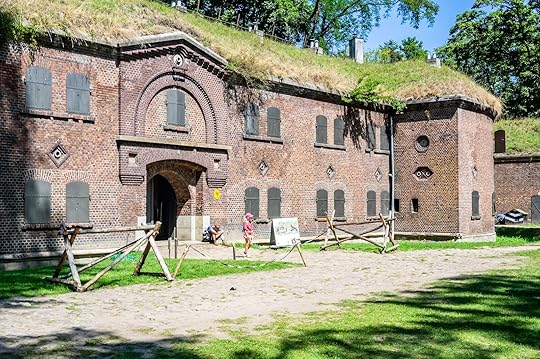
Some museums are meant to titillate — New York City’s Museum of Sex, for example. But apparently enough people in Poland are getting turned on by a historic war museum that an official statement had to be released asking visitors to please stop.
The Eastern Fort Museum on Wolin Island, housed in the historic Fort Gerhard, recently posted on Facebook that its new CCTV cameras caught three different couples having sex in the building on three different occasions.
“How to write it … Well, please: no ars amandi in the museum!” the post reads (originally posted in Polish). “We understand that unique exhibits and uniformed service can give you chills, EXCITATION and excitement! And for God’s sake- Beloved- especially those with hot blood- there is so much fun in the area. Guests in love, please understand – most of the Exhibits in our museum are objects ‘born’ many years ago and subject to completely different moral standards. Conservative, even orthodox and restrained. We do not expose them to discomfort!”
Hyperallergic notes that Fort Gerhard was originally built in the 1800s by the Prussian Empire. It was used first by the Prussian army and then by the Germans during Nazi occupation. It’s been a museum with historic war paraphernalia since 2001 and gets about 45,000 visitors per year. It’s yet to be determined if public sex acts encourage more or fewer guests.
Any potential voyeurs should keep in mind that public nudity and sex is illegal in Poland. Though the museum does have some advice for those interested in joining the crowd:
“Maybe it is worth taking a walk towards the wild beaches, which are abundant on the right bank of Świnoujście? So far, we only have cameras in the museum, the reflector barrack and the exhibition of items from the wreckage.” 
The 15 Best Epcot Restaurants for Delicious Dinners, Snacks, and Desserts

Disney parks are famous for many things, but the parks’ food offerings are surely at the top of the list. People travel to Disney parks just to try the Dole whip at Magic Kingdom or the yucca fries at Animal Kingdom–and the deep-fried and sugar coated snacks have garnered legions of fans. But many Disney fanatics agree that if you want a great meal or stellar snacks beyond the corn dogs and Mickey pops, you head to Epcot. The best Epcot restaurants offer a range of dishes from, French pastries, to braised pork and grilled seafood.
Since it opened in 1982, Epcot has lured visitors with its attractions based on eleven countries, futuristic aesthetic and permanent World’s Fair concept. More than a million visitors pass through its gates each month to ride the attractions, experience cultural events, and eat and drink their way around the park. And most people who spend a lot of time in Disney parks know that the best Epcot restaurants are miles above the restaurants in any of the other parks. If you’re looking to do Disney on a budget, this might not be the park for you, because you’re going to spend a lot of time eating outdoors.
Epcot has long been my favorite park, not just for its visual appeal, but for its food; I’ve sampled dozens of the park’s offerings from full-service meals to kiosk takeaways, and finally settled on a list of the best Epcot restaurants. For me, it’s not a vacation unless there’s great eats, and the best snacks at Epcot are all worth going out of your way to try. The best Epcot food is fresh made, family friendly, and served in an entertaining environment that makes this park feel like a real international vacation, done Disney style.
The park even hosts a renowned International Food and Wine Festival every fall. From the mezcal margaritas to the flaky pain au chocolat, the food at Epcot is the real deal. Here are the 15 best Epcot restaurants, where you can try the most delicious desserts, dinners, and snacks at the theme park.
1. Sunshine SeasonsIf you’ve already reached your limit of fried food, head to Sunshine Seasons, a food court in The Land pavilion of Future World. All the produce served at Sunshine Seasons is produced in The Land’s greenhouses, so it’s truly farm-to-table. The wood-smoked rotisserie chicken and grilled salmon are standouts, and a variety of stir fry, noodle and fruit bowls are some of the healthiest choices in the park, and certainly this could be called the one of the best Epcot restaurants for healthy food.
2. Rose and CrownJust past the back gate to Epcot at the entrance to the World Showcase, is the Rose and Crown, a quintessentially English pub serving fish and chips. Epcot fish and chips are beer-battered hake — crunchy, flavorful, and accompanied by a side of thick English chips best enjoyed when doused in vinegar. The Rose and Crown has an impressive scotch menu, as well as a variety of lagers and stouts on tap that make the perfect accompaniment. Followed up with a serving of the sticky toffee pudding, it’s a comforting meal in one of the best restaurants in the park.

Photo: Courtesy Walt Disney World / Todd Anderson
3. Space 220For an out-of-this-world dining experience, try the new Space 220 restaurant in Future World, adjacent to the Mission Space ride. Space 220 is as much about the atmosphere as the food, and you’ll pay for it. With a prix fixe of $79 per adult at dinner, the experience doesn’t come cheap. But there are some gastronomic winners on the mostly American menu. The Big Bang Burrata with artichokes, peppery arugula and romesco sauce is outstanding, as is the Blue Moon Cauliflower, tempura-fried cauliflower with house made hot sauce. You’re paying for the atmosphere and the chance to observe planet Earth from ‘space’ — if you can get a reservation. However, many of the salads and small plates can also be found on the Space 220 Lounge menu, which offers seating on a first-come basis.
4. La Hacienda de San AngelWhen your palate craves a spicy kick, the Mexican cuisine at La Hacienda de San Angel is hands-down some of the best food in the park. The meal begins with three complimentary salsas and house made chips, best complimented by one of the many handcrafted margaritas like the spicy El Diablo or the fruity Wild One margarita. Disney knows its margaritas and one could spend an entire evening soaking in tequila, but that would mean missing out on house specialties like the Conchinita Pibil, an achiote marinated braised pork, or the Parillada del Mar, a grilled seafood dish for two.
5. Regal Eagle SmokehouseFor traditional American barbecue dishes, the Regal Eagle Smokehouse offers smoked meats like North Carolina style chopped pork butt that is both smoky and tender. The Memphis dry rubbed pork ribs have a sweet and spicy kick that taste even better dipped in any one of the house made barbecue sauces.

Photo: Courtesy Walt Disney World / Harrison Cooney
6. La Crêperie de ParisOne of Epcot’s newest restaurants, La Crêperie de Paris is inspired by the Brittany region of France and mainly serves crêpes. The thin galettes filled with savory or sweet fillings are a lighter choice, but no less tasty. The Classique galette, a combination of ham and swiss topped with fried egg, is the most popular, but my favorite is the Savoyarde galette, with ham, Raclette cheese and caramelized onion.
7. Le CellierMeat lovers will also love Le Cellier, a cozy steakhouse in the Canada pavilion serving prime cuts of beef. The filets and strips are enjoyable, but you’ll probably enjoy the regional specialties celebrating Canadian cuisine, like Prince Edward Island mussels cooked in a lemony cream sauce served with ciabatta, even more. The poutine offerings like the signature poutine with Canadian cheddar, and a truffle and red wine reduction will remind you why there’s nothing better than cheese curds. For more cheesy goodness, try the Canadian beer cheese soup, the most popular item on the menu.
More like thisEpic Stays8 of the Coolest Airbnbs Near Disney World, Orlando8. Kabuki CaféWhen it’s time to cool off, head to the Kabuki Café in Japan for some kakigori, a shaved ice treat popular in Japan. It’s like a sno-cone since it’s essentially shaved ice with flavored syrup, except that kakigori offers a variety of toppings like sweet milk, sweet cherries and strawberries. It comes in unusual flavors like tangerine and melon and is generously sized for sharing.
9. BiergartenIf there’s one restaurant that’s an Epcot must-do, it’s Biergarten. Biergarten is a lively dinner and show atmosphere that transports you straight to Germany. You’ll sit at communal tables while enjoying German classics like schnitzel, sauerkraut, and sausages. The portions are mighty and satisfying. The massive dessert buffet serves a good chocolate cake and an apple strudel that is sweet without being cloying. The convivial polka band and full liter beer pours will have you shouting ‘Oompah!’ in no time.

Photo: Courtesy Walt Disney World / Harrison Cooney
10. Spice Road TableFor some of the most flavorful dining in Epcot, head to the Morocco pavilion to Spice Road Table. Spice Road Table is located along the World Showcase Lagoon and features small plates like excellent crispy spiced cauliflower and lemony dolmas.
11.Tangierine CaféAlso located inside the Morocco pavilion is Tangierine Café. While the menu at Tangierine Café is simple, the restaurant is located in a stunning tiled courtyard, and the well-seasoned kabobs and pillowy Moroccan bread with homemade hummus are consistently good.
11. L’Artisan des GlacesWhile the sweet Epcot crêpes are tasty, better options await at nearby cafés, including L’Artisan des Glaces At L’Artisan des Glaces, you’re there for the macaron ice cream sandwich, a Frenchified version of the ice cream sandwich that combines the chewy, subtle sweetness of a macaron with a dollop of ice cream.
12. Les Halles Boulangerie-PâtisserieAt Les Halles Boulangerie-Pâtisserie everything is delicious because everything on the menu — from the fraises to the napoleons – is made by professional pastry chefs. If you want to go full monty with the Parisian fantasy, it’s as simple as buying a freshly baked baguette to go. Stroll over the bridge with the sounds of “La Vie en Rose” drifting across the lagoon, while tearing off pieces of crusty baguette and you’ll easily be transported to another world.
13. Chefs de FranceChefs de France is routinely praised for its big portions that come at inexpensive prices. Serving family friendly French cuisine in a casual environment, you’ll find beef bourguignon, cheese plates, and steaks here. On TripAdvisor, visitors regularly commend the waiters for their friendly, attentive service. One of the best Epcot restaurants for French food, families might make a reservation here if they’re looking for a more refined, but not stuffy, night out.
14. Teppan EdoAt this teppanyaki style restaurant, where food is cooked by professional chefs at tables at on iron grills in front of diners, except a memorable experience. For people in the know, its considered one of the best Epcot restaurants, if not the best. The chefs provide entertainment to the guests, so you’re really getting both dinner and a show out of your reservation at Teppan Edo. The menu offers sushi, grilled shrimp, and even up scale options like lobster tail and filet mignon. Seated with other guests at communal tables, you just might end making friends with your seat mate.
15. Garden GrillThe main draw of Garden Grill is that it rotates, so you’ll be getting a full view of the agricultural-themed The Land Pavilion. Located near the Living with the Land boat cruise, this restaurant focuses on food inspired by harvests and farm life. This restaurant is a great option for kids too, because Chip, Dale, and more Disney characters come around the tables to take pictures and chat with the biggest Disney fans at your table. 
8 Michigan Lighthouses You Can Spend the Night In
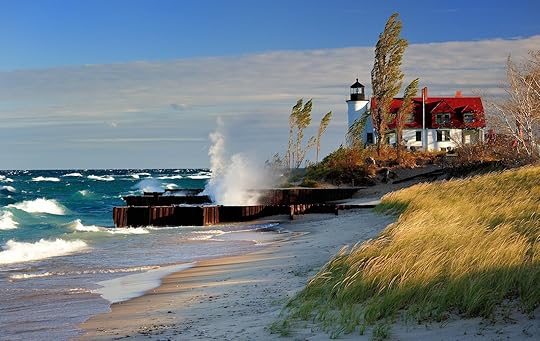
With 3,200 miles of Great Lakes shoreline, it makes sense that Michigan has more lighthouses – 129 – than any other state in the country. Many Michigan lighthouses are open to the public, have museum exhibits, and allow a climb to the top of the tower. Some of them are still active navigational aids.
Those who want to dive deeper into the legends and lore of lighthouse living can indulge in a stay at a beacon-turned-bed and breakfast, or pay-to-play as a volunteer lightkeeper. There’s no trimming wicks or checking lights every four hours as keepers once did, but tasks like offering tours, tending the gift shop, and sweeping floors are typical. And the sights and sounds of the freshwater seas, fierce storms, glorious sunrises and sunsets, and dazzling star shows are priceless. Here are eight Michigan lighthouses you can stay at.
We hope you love the Michigan lighthouses we recommend! Just so you know, Matador may collect a small commission from the links on this page if you decide to book a stay. Listed prices are accurate as of the time of publication.
Michigan Lighthouses on Lake MichiganBig Sable Point Lighthouse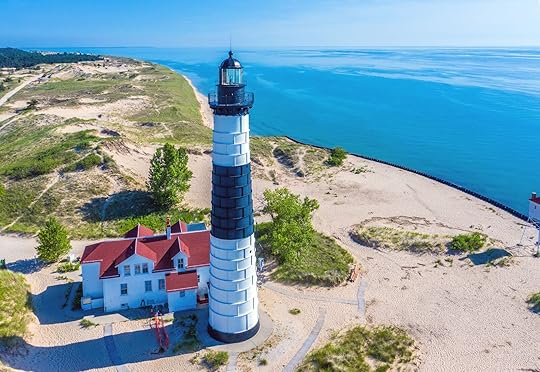
Photo: Frederick Millett/Shutterstock
The Michigan lighthouse: 1867, conical brick with metal sheathingAddress: Ludington State Park, 8800 W M116, Ludington, MI 49431What’s special: The ghost of keeper Henry VavrinaRate: No fee for the stay; there are membership and application feesIt’s an almost two-mile hike to this striking, 112-foot tower. The remoteness of Big Sable Point Lighhouse offers a hint of the isolation experienced by lightkeepers and their families. One of those keepers, the late Henry Vavrina, has made his ghostly presence known to multiple volunteers who share tales of his antics in a video on the lighthouse’s website.
The keeper’s quarters, with two living rooms, four bedrooms, two bathrooms, and kitchen, accommodates six or seven volunteers at one time. A two-week commitment is required between mid-April and mid-November. Duties include greeting guests, tower tours, gift shop duties, and light maintenance indoors and out. Membership in Sable Points Lighthouse Keepers Association is required.
Must do: Drive on mountains of sand in an off-road vehicle (yours or a rental) at the designated, 450-acre scramble area of Silver Lake dunes. Or hop on one of Mac Wood’s Dune Rides for the rare chance to roll across these natural wonders.
Grand Traverse Lighthouse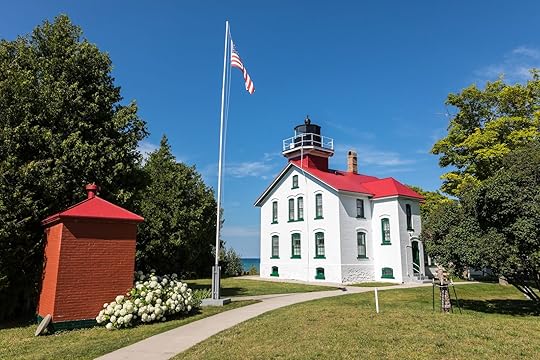
Photo: Craig Sterken/Shutterstock
The Michigan lighthouse: 1858 dwelling with square rooftop lightAddress: Leelanau State Park, 15500 N. Lighthouse Point Road, Northport, MI 49670What’s special: Ornate garden planter and other stone creations by 1920s Keeper McCormickRate: $200 per person per weekAt the tip of Michigan’s Little Finger, the light atop the red-roofed, gleaming white Cream City brick structure replaced the original, 1852 light, and guided vessels traveling the tricky Manitou Passage, as well as traffic heading into Grand Traverse Bay, until 1972, when an automated beacon was installed. The lightkeeper’s home is a museum furnished as it would have been in the 1930s, and the tower is open to climb for views from 103 feet above Lake Michigan.
Up to four keepers stay in the two-bedroom, two-level apartment. They greet visitors, provide information, staff the gift shop and handle light housekeeping duties six days a week, from April through October. In the off-season (November through March), keepers at Grand Traverse Lighthouse work three days and pay $100. Additional days are available at $25 per person per day.
Must do: Sip your way through some of the 23 wineries on the Leelanau Peninsula Wine Trail.
Mission Point Lighthouse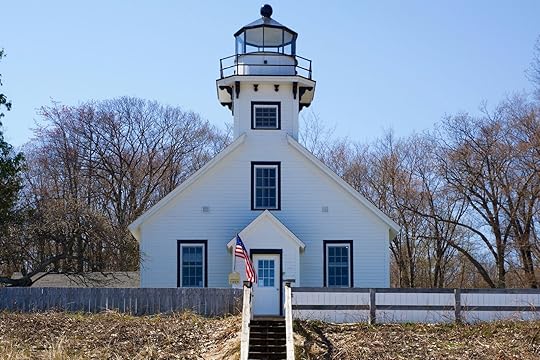
Photo: Christian Heinz/Shutterstock
The Michigan lighthouse: 1870, square, integrated in dwellingAddress: 20500 Center Road, Traverse City, MI 49686What’s special: At the 45th parallel, halfway between the Equator and North PoleRate: $200 per week per couple, or $370 for a two-week stayIt’s a lovely, 18-mile drive past vineyards and cherry orchards to the tip of Old Mission Peninsula and Mission Point Lighthouse. Located in a county park, the white, wooden structure is surrounded by woods, trails, and the rocky beach. Visitors to this Michigan Lighthouse museum enjoy exhibits, the 37-step tower climb, gift shop, and a peek inside the historic Hessel log house, which was moved to the site as an example of cabins built by early settlers.
A team of two volunteer keepers greets visitors, handles the gift shop, and performs light maintenance duties indoors and out, six days a week for one or two weeks, from April through November. An off-season stay of three days or more is possible from December through April at $75 per night.
Must do: Sample the fruit of the vine at the 10 wineries along the Old Mission Peninsula Wine Trail.
Point Betsie Lighthouse
Photo: John McCormick/Shutterstock
The Michigan lighthouse: 1858 cylindrical towerAddress: 3701 Point Betsie Road, Frankfort, MI 49635What’s special: The last Michigan lighthouse to be automated, in 1983Rate: $3,495 per weekStill active as a navigational aid, the Point Betsie Lighthouse offers guided tours of the original keeper’s home, including the 34-step climb to the top of the tower. Both were built of Cream City brick, and the photogenic structure has a distinctive, red gambrel roof. The compound includes the fog signal building, Boathouse Museum, and gift shop.
The keeper’s quarters is a comfortable, freshly decorated two-bedroom, one-bath apartment with full kitchen and sitting room with sofa bed. It accommodates up to six guests for weekly rental from Mid-May through mid-October at the rate of $3,495. Shorter stays are possible in May, September and October at $550 per night.
Must do: Tackle the massive Dune Climb, hike the trails, and take in spectacular views along Pierce Stocking Scenic Drive at Sleeping Bear Dunes National Lakeshore.
Michigan Lighthouses on Lake HuronPointe aux Barques Lighthouse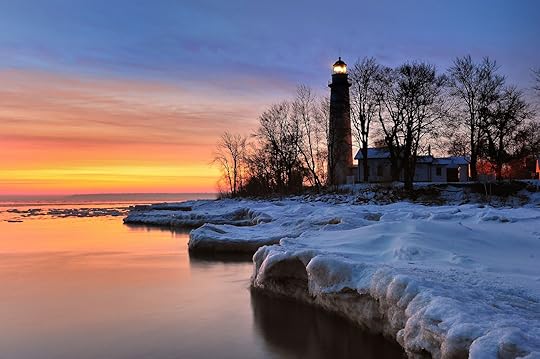
Photo: John McCormick/Shutterstock
The Michigan lighthouse: 1857 cylindrical brick towerAddress: Lighthouse County Park, 7320 Lighthouse Road, Port Hope, MI 48468What’s special: First female lightkeeper in MichiganRate: $100 per person per weekLocated near the tip of mitten-shaped Michigan’s Thumb, this 89-foot tower is one of the oldest continuously active lights on the Great lakes. The original light at this site was the first in Michigan to be operated by a woman. In 1849 Catherine Shook, the widow of lightkeeper Norman, assumed his duties while raising their eight children, and may be the ghost said to visit the Pointe aux Barques Lighthouse compound. This stretch of Lake Huron is the graveyard for at least 105 vessels, and a destination for divers who explore 22 wrecks protected by the Thumb Area Bottomland Preserve.
Volunteer keepers in teams of two or four stay in the 1908 assistant keeper’s home. In addition to docent duties, keepers staff the gift shop and handle light housekeeping six days a week for a minimum of one week, from June through September.
Must do: Kayak to Turnip Rock, a limestone formation carved by the waves to resemble the root vegetable. It’s been nationally recognized as a geological wonder and is accessible only by water.
Tawas Point Lighthouse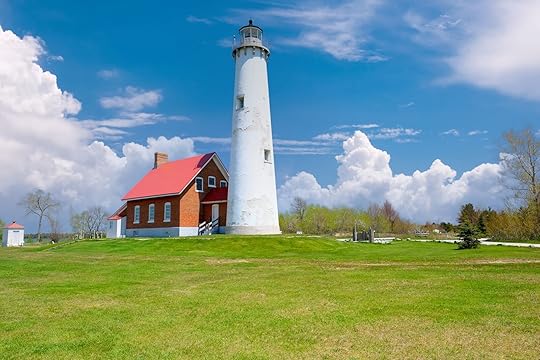
Photo: haveseen/Shutterstock
The Michigan lighthouse: 1876 conical brick towerAddress: Tawas State Park, 686 Tawas Beach Road East Tawas, MI 48730What’s special: Watch the sunrise over Lake Huron and set over Tawas BayRate: $250 per person per two-week stayWhy is this Michigan lighthouse surrounded not by water but by grass, a mile and a half from the Great Lake traffic it was built to guide? When constructed in 1876, Tawas Point Lighthouse stood at the end of Tawas Point, but over the decades Lake Huron moved enough sand to create a new spit, rendering the lighthouse too far from shore to be of navigational use; an automated light now marks the entrance to Tawas Bay. It’s 85 steps to the top of the tower and the views of the area called the “Cape Cod of the Midwest.”
Teams of four volunteer keepers are housed in the Victorian-era dwelling and offer tours and handle light housekeeping duties six days a week for a minimum of two weeks, from mid-May through mid-October.
Must do: Drive the River Road Scenic Byway to take in the views and learn about the area’s logging history.
Michigan Lighthouses on Lake SuperiorBig Bay Point Lighthouse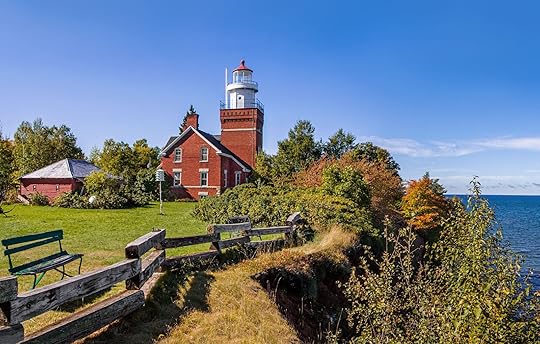
Photo: Doug Lemke/Shutterstock
The Michigan lighthouse: 1896, square red brickAddress: 4674 County Road KCB, Big Bay, MI 49808What’s special: Serenity massage in a secluded hut 30 feet above Lake SuperiorRate: $205 (forest view) to $425 (lake view) per nightStill an active navigational aid, Big Bay Point Lighthouse is located 25 miles north of Marquette, the largest city in the Upper Peninsula. Surrounded by 40 acres of woods and perched high above Lake Superior, the inn welcomes adult guests from May to mid-November to its seven richly decorated rooms, some with fireplaces. All have private baths, and guests may climb the tower for expansive views 120 feet above the water.
Must do: Hang out at the scene of the crime in Big Bay, where a shooting at the Lumberjack Tavern inspired the 1959 movie starring James Stewart and Lee Remick.
Eagle River Lighthouse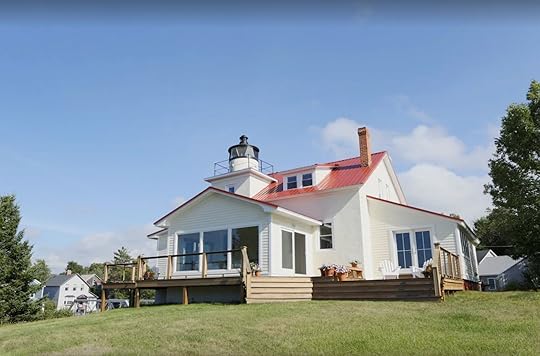
Photo: Eagle River Lighthouse/Vrbo
The Michigan lighthouse: 1858, square tower integrated into dwellingAddress: On the Eagle River, Eagle River, MI 49950What’s Special: Whole house rentalRate: $463 average per nightIn the mid-1800s, Eagle River was a boom town thanks to the copper discovered at nearby Cliff Mine. The busy new port necessitated construction of a lighthouse, which operated from 1858 until it was decommissioned in 1908.
The historic structure has been transformed into a bright and breezy, 3,000-square foot, year-round Vrbo rental. Contemporary, with the warmth of wood throughout, the home offers three bedrooms for up to six guests, a complete kitchen, and spacious gathering spaces including a large deck. The light tower is not accessible to guests.
Must do: Explore the mining history of Copper Country through the Heritage Sites of the Keweenaw National Historical Park. 
Watch People Race Camels, Ostriches, and Zebras at This Wild Small-Town Nevada Event

Many people’s perception of the Nevada desert is limited to a single city illuminated by neon and dripping with vice. Far to the south by the border with Arizona, however, you’ll find a scene that feels more like the sands of Saudi Arabia than a corner of Nevada. On the second weekend of September in the small historic mining town of Virginia City, camels, zebras, and ostriches descend on the desert and compete for glory at the International Camel & Ostrich Races.
The International Camel & Ostrich Races started in 1959. It’s rooted in the rivalry between two newspapers: the Virginia City local Territorial Enterprise and the San Francisco Chronicle. The editor of the Territorial Enterprise had printed a false story about camel races in Virginia City as a hoax, and the editor of the Chronicle, believing it was real, reprinted it. Embarrassed about being fooled, a Chronicle editor borrowed a camel from the San Francisco Zoo and sent a team to race it in Virginia City. The tradition has been in place ever since, only now it also involves ostriches and zebras (note that while ostrich riding was once more popular, riding has declined in recent years as the wild animals can be dangerous and experts say no one over 200 pounds should ride an ostrich). Guests also have the opportunity to ride a camel.

Photo: Sydney Martinez
Virginia City isn’t just famous for an offbeat racing culture, either. The Territorial Enterprise is the paper where Mark Twain got his first writing gig, and the town itself is where the Comstock Lode of silver ore was discovered in 1859. Camel racing is simply the city’s most current claim to fame.
This year, the race takes place from September 9 to September 11, at the Virginia City Fairgrounds. The festivities kick off with a Friday night race, and continue with two events on Saturday and Family Day on Sunday. Tickets are $20, though VIP seating and amenities are available for additional cost. 
Menstrual Cups Make Traveling During Your Periods Cheaper, Easier, and Greener

For people who menstruate, it can be frustrating to start a period while on vacation. Most adults use tampons, which have to be refreshed frequently and disposed of in an appropriate place like a trash can. And then, perhaps most importantly, once they run out, tampons or pads need to be replaced — or you’ll be stuffing toilet paper down your underwear. There might be a solution to these travel woes, however: the menstrual cup.
While there are many alternatives to tampons that travelers can use, the menstrual cup might be the most convenient. Though it’s still not as popular or as widely available as tampons or pads, the menstrual cup is extremely efficient. Once inserted, the small rubber cup collects the menstrual fluid, and it just needs to be emptied every 12 hours or earlier depending on your flow, while it’s recommended that tampons be changed every four to eight hours. The risk of toxic syndrome is rare in users of menstrual cups compared to that of tampons (only two cases have been reported, in people who left the cup inserted for 7 days.)
If you’re hiking or camping, handling a period can be especially messy and inconvenient. Long bus ride in a rural community, an extensive kayaking trip, or an overnight drive would also be difficult environments to find a bathroom where one could comfortably and privately replace a tampon and wash up afterwards. With the menstrual cup, you can have the option to wait a longer period of time until a bathroom becomes available.
Once you get to a bathroom, you simply dump the contents and use water and soap to wash the cup and your hands before reinserting — and because most outdoors enthusiasts carry a bottle of water and a bar or small bottle of liquid soap with them, this is achievable in even the most remote locations.
Plus, there’s no reason to stress about finding a store to buy more pads or tampons once you run out. This might not be a serious worry in modern cities, but there are plenty of locations where travelers could find it harder to replenish their supplies.
And there’s another upside: It won’t take up space in your luggage, a huge plus for travelers packing economically (another option is to pack period underwear, like Knix underwear, which absorb the menstrual fluid, but you would need ready access to washing machine in order to consider this option.)
“It’s so small and barely takes any space in my luggage. I have it in my toiletry bag with my makeup, toothbrush, and skincare. It’s got a protective cover, and you only have to pack one because you’re just using the one throughout the duration of your period, versus throwing away multiple pads or tampons daily,” Amanda Meeks, a travel blogger who recently wrote a thread on Twitter praising the usefulness of the menstrual cup while traveling, tells Matador Network.

Photo: Yulia Grigoryeva/Shutterstock
Meeks waits until the end of the day, empties the cup, cleans it with soap and water, and replaces it. Of course, when users need to empty the cup will depend on their personal flow, and most brands of menstrual cup come in a variety sizes to fit diverse body types. In terms of fit, the Diva Cup, which Meeks uses, has a slim nub hanging from the bottom of the cup, which is supposed to make it easier to grip and remove. It can be trimmed down until the cup fits comfortably.
“I put it in for the first time and sat down and basically said ‘Oh I can feel that,’ and started just trimming that nub back until I could no longer feel it. You don’t need the nub to get the cup out by any means, but I think it’s supposed to make it simpler,” she explains.
As anyone who has used one knows, a tampon can feel stiff or irritating, so for people who take part in a variety of outdoor activities while traveling, a menstrual cup offers comfort that feels a world away from a chafing tampon.
“I’ve used it while hiking, running, scuba diving, surfing, at aerial and yoga classes, and on camping trips,” adds Dylan York, a content strategist at Matador Network, who has used a menstrual cup for nearly five years.
It’s just as easy to remove and store once your period ends. When her cycle ends, Meeks boils it to keep the cup free of bacteria, then replaces its protective cover until it’s needed again (this step of the process would of course require access to boiling water, which in some places, can pose a problem, and might be considered a drawback).
Meeks also appreciates that the menstrual cup is more environmentally friendly, as it creates less waste than tampons. In fact, that’s the primary reason that Meeks switched to a menstrual cup.
“I was trying to see what easy things I could do to reduce waste in my life and did some research and that was one. You literally don’t throw anything away, you just wash it at the end of your period,” she says.
While a more sustainable approach to periods, that saves money and space in your luggage, is probably incredibly enticing to people who frequently travel, there are some downsides to consider.
“I’ve used a cup once. There’s definitely a learning curve, and my first thought afterward was how awful it would’ve been to try to use, for the first time, on an airplane, while camping, in a restaurant bathroom, or really any public place, especially if the sinks are separate [from the stalls],” Matador Network’s senior staff writer Alex Bresler, who travels at least twice a month, tells me.
If you’re planning to switch to a menstrual cup to use on your next adventure, you should consider testing it out before you leave to make sure you have the right fit and know exactly how to use it. Otherwise, whether you’re planning a minimalist trip backpacking in the wilderness, or want to spend a month at sea, where convenience stores are non-existent, a menstrual cup might turn out to be a blessing. Not only will it save you space, and help save the environment, it might bring you peace of mind, too. 
This Epic Bali Treehouse Puts You High Above the Lush Jungle

Are you looking to seclude yourself from everything and everyone? This treehouse stay can help out with that. This remote treehouse is located in beautiful Sideman, Bali, and if you’re looking for a relaxing and rustic off-grid vibe for your next adventure, the Bird Hills Bamboo House could be it.
@megan.milan Replying to @sun.eye444 ♬ The beach by the neighbourhood – Bob Ross
The Bird Hills Bamboo House is located in eastern Bali and is the first treehouse on the island that actually meets the definition of the term. The Bali treehouse Airbnb is almost entirely made out of bamboo and is made of 90 percent recycled material. With stunning views of Karangasem’s green landscapes, this treehouse will surely put you in a hypnotic state of relaxation.

Photo: Airbnb

Photo: Airbnb

Photo: Airbnb

Photo: Airbnb
The treehouse was recently updated with the addition of an extra room called the treehouse’s “central area,” and now this unique accommodation can fit up to five people. This spacious treehouse also has the main living space that features a shared kitchen and dining area, two outside bathrooms, a two-room balcony, and the bamboo villa separated by a wooden bridge.
If you’re looking for a bucket list adventure to add to your list then check out The Bird Hills Bamboo House. The perfect place to unwind, meditate chill and hide from real life for a while. Ready to pack up and take on this new adventure then check out this awesome Bali treehouse Airbnb. 
The 15 Best-Rated Luggage Options on Amazon for Under $100

Whether you travel regularly or for the odd vacation, having quality luggage is important. These affordable and top-rated picks are the most highly rated suitcases, totes, and duffles on Amazon. Varying in style, color, sizes, and extra features such as USB chargers and coffee cup holders, we’ve filtered through the comments and ratings, so you can clearly see what is worth spending your hard-earned dollars on. Here are 15 of the best Amazon luggage options under $100.
We hope you love the Amazon luggage we recommend! Just so you know, Matador may collect a small commission from the links on this page if you decide to book a stay. Listed prices are accurate as of the time of publication.
American Tourister Moonlight hardside carry-on
[image error] [image error]If you are traveling domestically and looking for a hardside carry-on, this suitcase from American Tourister is an excellent option. With over nine thousand reviews, four-and-a-half stars, and Amazon Choice status, customers rave about its chic rose gold color, 360 spinner wheels, and lightweight. It comes in at 21 inches, but reviews mention it’s specious enough for a five to seven-day trip away. This purchase through Amazon is also guaranteed for ten years.
Price: $71.99
Fabric expandable carry-on luggage set
[image error] [image error]Incredible value, this Amazon luggage set includes a foam padded tote and expandable four-wheeled suitcase. It comes in various colors, but we love this fun purple combo. It also has multiple meshed zippered pockets to secure your items during travel. Positive reviews touch upon how spacious the suitcase is for a carry-on, the quality of the fabric, and how handy the tote is for personal goods and electrical items such as laptops and cables.
Price: $66.65
Lightweight durable hardside four-wheel carry-on
[image error] [image error]Another classic Amazon luggage hardback, four-wheeled, carry-on is this smokey purple suitcase. It has almost 15 thousand reviews with four-and-a-half stars. Its reinforced protective molded corner guards give an extra element of durability and the shock absorbent design is highly rated. The interior of the main compartment is fully lined with a tear-resistant lining and it has a zippered organization pocket, and garment restraint straps to hold your belongings in place.
Price: $81.17
Bago overnight duffle bag
[image error] [image error]Investing in a decent duffle is a game-changer in packing for short trips. and this Bago duffle is not an expensive purchase. It comes in 13 different colors and ranges in capacity from 40 to 120 liters. One of its key features is its waterproof compartment which is ideal for electrical goods. The larger duffels are wheeled, so make sure to read through the different features to make sure you purchase the perfect option for your travel needs.
Price: $39.99
Softside upright luggage set
[image error] [image error]If you found the purple two-piece above a little flashy, have a look over this classic black combo. It has over 50 thousand reviews, again with four-and-a-half stars. With its heavy-duty polyester and PVC backing the set has been designed to be durable and many reviews mention how sturdy and robust both bags are. As well as the black and colored pipping combinations, they have various jazzy patterned designs. Oh, and it’s under $50.
Price: $47.56
Padded under-seat carry-on
[image error] [image error]If overhead bin space is a concern, you may want to consider investing in an under-seat carry-on such as this black padded bag. This is a great option if you’re looking for a bag for business travel. The bag has a handy sleeve that fits most 15-inch laptops.
Price: $79.99
Amazon Basics 21-inch hardside (bestseller)
[image error] [image error]Another Amazon luggage bestseller, this hardside 21-inch carry-on is practical and stylish. With over 30 thousand reviews, and a four-and-a-half star rating the suitcase is expandable, so it’s great for short or long trips. Flight attendants verify its dimensions, ease to roll, and durability.
Price: $65.01
Two-piece lugggage set with cup holder and USB port
[image error] [image error]If you are anything like me and find yourself juggling your passport, cell phone, boarding pass, carry-on, laptop, and coffee, this luggage set is a life-saver. Wrangler’s stylish teal two-piece also has a USB charger and phone holder. It’s highly rated for being lightweight and durable. It’s also lined and has various pockets for organizing your vacation gear.
Price: $76.00
Three-piece softside upright luggage
[image error] [image error]What’s the catch? Three-piece luggage for under $70? There doesn’t appear to be one, as over seven thousand reviews can put your mind at rest. Ultra light-weight, decent wheels, multiple interior pockets, and a very reasonable price tag makes the American Tourister set a good option for those looking for a practical budget-friendly purchase. It also comes in various colors, black, navy, purple, and red.
Price: $69.97
Expandable rolling suitcase
[image error] [image error]We love this suitcase because it’s foldable, which is fantastic if you are away for a longer vacation and don’t want to be tripping over your bag or worrying about it fitting under the bed. It’s scratch and tear-resistant, durable, and has four spinner wheels. It can also be adjusted into three different sizes.
Price: $78.99
15-inch under seat carry-on with USB charging port
[image error] [image error]This under-seat, 15-inch smart bag has a USB charger. Its handy outside pockets are great for storing valuables that you need easy access to. The only downside is that it only accommodates a 12.5-inch laptop. Its top handle means it’s liftable, or you can use an expandable handle and roll. It also comes in black, brown, purple, and navy blue.
Price: $59.00
31-inch softside suitcase with spinner wheels
[image error] [image error]This large soft-side comes in at 31 inches and is made from durable twill polyester. Its push-button handle is adjustable to different heights and it features four 360-degree spinner wheels for easy mobility. A great option if you are traveling with kids or going on a long vacation.
Price: $99.40
Three-piece teal carry-on luggage set
[image error] [image error]This three-piece Amazon luggage set; suitcase, boarding tote, and washbag, come in six different colors and is a steal at $59.43. The main suitcase is carry-on size and has four spinner wheels. The 15-inch tote has a handy strap that attaches to luggage trolleys. Check out the Sky Collection brand for other packages which vary in size.
Price: $59.43
30-inch multi-pocket upright rolling duffel bag
[image error] [image error]We love a pocket, and this 30-inch rolling duffel has multiple. It’s available in twelve different color combinations and has a 77-liter volume capacity. Designed for outdoor adventures and longer vacations, this duffle will have you 100 percent organized during your travels.
Price: $87.99
Wrangler rolling duffel bag
[image error] [image error]Another superb product from Wrangler, this rolling duffel comes in four different designs and is an absolute steal at $44.00. It’s made from nylon, is durable, and is super spacious for easy packing. It has a four-and-a-half star rating with customers raving about its lightweight structure and value for money.

Price: $44.00
More like thisTechnology + GearHow To Travel With a Carry-On Only, According To a Professional PackerAugust 7, 2022
11 Top-Rated Airbnbs in Destin, Florida, for the Ultimate Coastal Escape

Destin, Florida, is known for its sandy and emerald Gulf of Mexico beaches. Destin is your place if you’re looking to immerse yourself in beautiful beaches, tasty seafood, and world-class fishing. It’s also prime for family time and known for picturesque, challenging golf courses. These Airbnb Destin Florida properties set you up for easy access to everything the area has to offer — with a comfortable pad to relax in afterward. Bonus!
Beachfront Airbnbs in Destin, FloridaPet-friendly Airbnbs in DestinDestin Airbnbs with a poolAirbnbs in Ft. Walton BeachMiramar Beach AirbnbsWe hope you love the Airbnb Destin Florida stays we recommend! Just so you know, Matador may collect a small commission from the links on this page if you decide to book a stay. Listed prices are accurate as of the time of publication.
Beachfront Airbnbs in Destin, FloridaThe best Destin Airbnbs are located right near the beach — and these vacation rentals are proof. Steps from the water, you’ll enjoy both comfortable accommodations plus ultimate convenience
Modern oceanfront condo
Photo: Airbnb

Photo: Airbnb

Photo: Airbnb
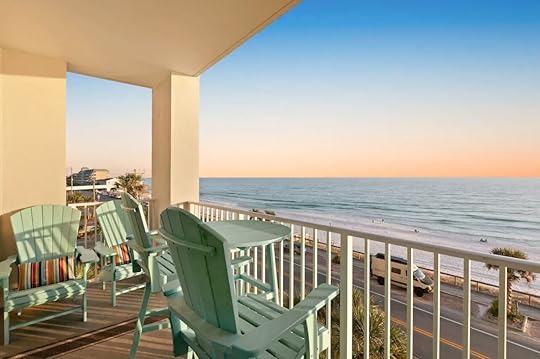
Photo: Airbnb
Enjoy some fun in the sun with this waterfront condo. The condo features a fully equipped kitchen with stainless steel appliances, a breakfast bar, and a spacious living room with sliding glass doors leading to the patio area. The furnished patio area faces the gorgeous waterfront, and it’s perfect for relaxing after a long day at the beach.
Six guests, one bedroom
Price: $358 per night

Photo: Airbnb

Photo: Airbnb

Photo: Airbnb

Photo: Airbnb
Relax, hang out on the beach, and repeat could be your regular route at this remote oceanfront space. This secluded condo is the perfect place for couples or singles to come and relax and get away from it all. It features a full kitchen and spacious living room that leads out to the patio with front-row seats of the stunning ocean.
Four guests, one bedroom
Price: $222 per night

Photo: Airbnb

Photo: Airbnb

Photo: Airbnb
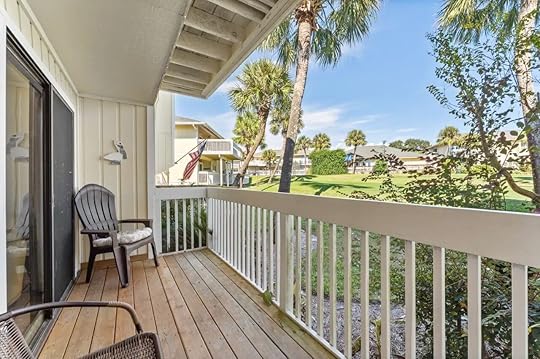
Photo: Airbnb
This Airbnb Destin Florida property is perfect for a peaceful beach getaway. This first-floor condo has a 24 hour guarded and gated resort on 43 acres. Enjoy the amenities like private beach access, five pools, tennis courts, shuffleboard, and more. This newly renovated condo has a full kitchen living space with doors leading to the patio area.
Six guests, one bedroom
Price: $168 per night

Photo: Airbnb

Photo: Airbnb

Photo: Airbnb
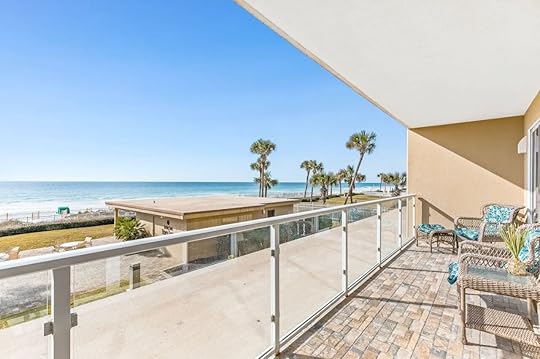
Photo: Airbnb
Here is another gorgeous oceanfront view condo for your next Destin getaway. This stunning oceanfront condo has a kitchen and spacious living room that leads to the extended balcony outside. Each bedroom is equipped with a ceiling fan and television. The apartment is just a short walk away from The Back Porch and just half a mile away from Henderson Beach State Park, where there is plenty of wildlife to see and fish to catch.
Six guests, two bedrooms
Price: $518 per night

Photo: Airbnb

Photo: Airbnb

Photo: Airbnb

Photo: Airbnb
Sit back and relax at this tranquil studio on the beach. Situated waterfront, the pad features all new furniture and appliances and would be the perfect base for your Destin vacation. Enjoy the sunrise and sunset views and the soothing background noise of the waves right on your patio. There are also fun outdoor activities at the Crab Island Watersports, less than two miles away. Wild Willy’s Adventure Zone is just four miles away and offers many family-friendly activities if you want to stay more inland.
Four guests, one bedroom
Price: $365 per night
Dogs love the sea, too, and these pet-friendly Airbnbs in Destin mean there’s no reason to leave them at home.
Dog-friendly beach home near Silver Sands Premium Outlets
Photo: Airbnb

Photo: Airbnb

Photo: Airbnb

Photo: Airbnb
This gate Sandpiper Cove complex is waiting for you. This Airbnb Destin Florida property offers easy access to the beach and can accommodate up to six guests and even the family dog if you want to bring them along. The condo has a full kitchen, shared pool, and hot tub, and it can accommodate up to two dogs. Enjoy the fresh Destin air on the spacious furnished balcony and catch a sunset while you’re at it.
Four guests, two bedrooms
Price: $212 per night

Photo: Airbnb

Photo: Airbnb

Photo: Airbnb

Photo: Airbnb
Enjoy your home away from home with this Airbnb, a Destin, Florida, beachy bungalow. Gather up the family and make your way to this beautiful bungalow located just a few hundred yards from the beach. Its large corner lot has plenty of space and privacy for the family and the kids to run around. With its spacious backyard, kitchen, and living room, this home is sure the beach lover’s dream vacation.
Fourteen guests, four bedrooms
Price: $105 per night
Noting beats a cool down in the pool at the end of a beach day. Except for waking up and taking a dip before heading to the beach. Both experiences are yours to enjoy at these Destin Airbnbs with a pool.
A wave from it all beach home with private patio
Photo: Airbnb

Photo: Airbnb

Photo: Airbnb

Photo: Airbnb
Gather up your family and friends and call this beach adobe your home base for your Destin, Florida, getaway. This spacious and cozy home has everything you need for a family or friend vacation. The house has all its living space located on the ground floor, making them accessible for anyone, and there is a full kitchen equipped with all appliances and a breakfast bar. The vast living room has board games and all forms of entertainment and has a door that leads to a private enclosed yard. Outside is a private pool, fire pit, and outdoor area perfect for grilling out in the Florida sun.
Eight guests, four bedrooms
Price: $198 per night

Photo: Airbnb

Photo: Airbnb

Photo: Airbnb

Photo: Airbnb
Vacation is supposed to be heavenly, after all — so you might as well book this property in Destin’s acclaimed Emerald Waters community just outside the city center. The owner promises no more that 490 steps to the beach — and that’s if you take small steps. In addition to nearby waves, take advantage of the pool and a cozy outdoor deck and patio ideal for lazy happy hours. There’s something about fruity cocktails that just goes so well with the calm waters of the Gulf of Mexico, and this home has room for your entire crew to take advantage. Accommodating up to 14, this property is the best deal in Destin — and that’s before your step count to the beach is taken into consideration.
Fourteen guests, four bedrooms
Price: $205 per night
SeaBlue house with heated pool
Traveling to Florida? Check out Matador’s guides to the best places to stay in the state:
The 12 best Miami Airbnbs from South Beach to Little Havana The best 11 Airbnbs near Universal Studios 8 of the coolest Airbnbs near Disney World, Florida 15 beautiful Florida Airbnbs for every type of traveler 6 Kissimmee Airbnbs for a multi-generational family Disney trip 11 Key West Airbnbs to experience the best of the island

Photo: Airbnb

Photo: Airbnb

Photo: Airbnb

Photo: Airbnb

Photo: Airbnb
This remodeled home is the perfect place for your dream beach vacation. This beach home features a chef-like kitchen with all the appliances that one would need to cook up a meal for the whole family, along with a dining table fit for ten and a breakfast bar made for four people. The spacious living room at this pet-friendly Airbnb in Destin opens up the bright beachy home and has doors that lead to the deck, the backyard, pool, and hot tub. There are multiple seating options, a gas grill, and an outdoor shower to rinse off the sand from the beach.
Twelve guests, four bedrooms
Price: $948 per night

Photo: Airbnb

Photo: Airbnb

Photo: Airbnb

Photo: Airbnb
Welcome to this coastal villa retreat that gives you the best of both worlds. This retreat is between the lake and the beach and offers two private patios with gorgeous views. The home offers an open living area with comfortable seating and large windows with natural lighting. The kitchen is equipped with all appliances and food and has a dining table that can fit six people. The home is located right off the Iconic Scenic Highway 98 and near plenty of dining, shopping, and local entertainment and attractions.
Six guests, two bedrooms
Price: $237 per night
Just west of Destin, Fort Walton Beach is a beautiful destination with an extremely relaxed attitude. These Airbnbs in Fort Walton Beach are walkable to the sand.
Beautiful pet-friendly Airbnb in Fort Walton Beach
Photo: Airbnb

Photo: Airbnb

Photo: Airbnb

Photo: Airbnb
Easy access to Okaloosa Island is a prime attraction for those visiting Fort Walton Beach. It gets no easier than from this pet-friendly Airbnb, a private home with a private pool and an expansive backyard. The home is great for groups looking to head out at night on the island, or for families visiting to relax as there are playpens and a booster chair in the kitchen.
Nine guests, four bedrooms
Price: $235 per night

Photo: Airbnb

Photo: Airbnb

Photo: Airbnb

Photo: Airbnb
Stay right on Okaloosa Island in this cozy condo right on the sand. This condo comes with private beach access and makes it easy to get to amenities like nightlife, dining, and shopping. Inside, the spacious living room opens to a large balcony that is a great place to enjoy a coffee in the morning and a cocktail as the sun goes down.
Five guests, two bedrooms
Price: $286 per night
Miramar Beach is just east of Destin. Staying at an Airbnb in Miramar Beach is ideal because the town is smaller and very relaxed, but you’re just up the road from all the action in Destin. Miramar Beach is one of the cheapest beach vacations in the US, which makes these properties a great deal.
Gulf-front condo with balcony
Photo: Airbnb

Photo: Airbnb

Photo: Airbnb

Photo: Airbnb
Make the most of your beach vacay at this beachfront condo in Miramar Beach. You’ll have a great balcony perfect for watching the sunset, along with a modern interior that includes all the trimmings of home. The bedroom and living room each offer a great view, and allow you to choose your spot on the sand before you even head down.
Six guests, one bedroom
Price: $223 per night

Photo: Airbnb

Photo: Airbnb

Photo: Airbnb

Photo: Airbnb
The best part about this Airbnb in Miramar Beach is that you get both the luxurious amenities of a beach resort along with the comfort and security of booking through Airbnb. With two large pools right on the beach, this condo is the perfect escape from the grind whether you plan to visit for a weekend or a month. It’s new, well-designed, and offers easy access to everything along the Emerald Coast.
Eight guests, two bedrooms
Price: $150 per night
Paris Syndrome Explained: Is Paris Worth the Hype?

Almost everyone longing for travel has a dream destination — whether it’s catching rays on your overwater bungalow in the Maldives, going on the safari of a lifetime in South Africa, or getting swept up by the magic and romance in Paris. The unfortunate reality is that when you build up a destination in your head like that, there’s plenty of room to be disappointed when things don’t go as planned. And that has happened enough with people who visit Paris that it has its own name: Paris syndrome.
After years of pandemic-related travel restrictions, tourists are getting out into the world in droves. If you’ve always wanted to visit the City of Light, Paris likely was on your list. But those who do adore the city say it’s crucial to manage your expectations — sit down and enjoy the comforts of the little cafes and just ease your way into it. As the comments on a post about Paris syndrome from the solo traveler Ciara show, Paris syndrome didn’t end with the pandmic.
View this post on InstagramA post shared by Ciara | Solo Female Travel (@hey_ciara)
So just how common is Paris syndrome? Here’s everything you need to know about the travel disillusionment.
What is Paris syndrome?Paris syndrome is an extreme form of culture shock. While there should be some expectation of culture shock wherever you travel, the biggest culture shocks are usually reserved for expats or students studying abroad who settle into a new country for months at a time versus short-term travelers. Paris syndrome happens when people visit for a vacation. As Mathieu Deflem, a professor of sociology at the University of South Carolina, told Live Science, it originally referred primarily to travelers from Japan.
The way Paris is portrayed in the media is why many people want to visit — but the reality is that Paris is a real city and not something out of the romantic comedy Amélie (or, worse, Emily in Paris). The streets certainly don’t smell like expensive perfume. In a 2020 study by CEOWORLD magazine, Paris was rated the number one rudest city in Europe by 36 percent of respondents, which is double the second place rating of London. There are also the things that every densely populated city deals with, including rats and mice (and not of the Ratatouille variety), trash, graffiti, pickpockets, and various unpleasant aromas.
Is Paris syndrome real?Although Paris syndrome is rare, it is very real. In 2006, NBC News reported that about a dozen or so tourists get severe cases that need medical attention. That year, the Japanese embassy in Paris repatriated at least four visitors who had severe cases — including two women who believed their hotel room was bugged.
What are the symptoms of Paris syndrome?The symptoms are very similar to anxiety and psychosis. According to The Atlantic victims typically experience acute delusions, hallucinations, dizziness, sweating, feelings of persecution, and even vomiting.
How can Paris syndrome be prevented?Although Paris syndrome sounds scary, Paris is still a city of marvel and wonder. Tourists should simply remember that, like any city, it will have its pros and cons. So embrace the chance to slow down while the waiter takes their sweet time bringing you your coffee, marvel at the lights on the Eiffel Tower while swiftly ignoring the vendors selling merchandise below. Keep your eyes peeled for any scams. Spend some time on Duolingo and pick up some basic French. By keeping your expectations realistic, you’re sure to love Paris for all it has to offer. 
August 6, 2022
Arizona’s Seasonal ‘Chocolate Falls’ Are Taller Than Niagara Falls

If you’ve ever wanted to see something like the chocolate falls from Willy Wonka and the Chocolate Factory, you might want to take an impromptu trip to Arizona. A natural phenomenon only happens a few times a year has made its way to the Navajo Nation.
@djandthelou 6 years in AZ & there is still so much beauty to be seen!!!#grandfalls #az #desert #flagstaff #waterfall #navajonation #chocolatefalls #arizona #monsoon ♬ Electric Pow Wow Drum – The Halluci Nation
The Grand Falls, nicknamed the “chocolate falls,” is located 30 miles East of Flagstaff in the Painted Desert. At its peak, the falls reach over 181 feet tall, which is taller than Niagara Falls. According to the Navajo Tourism Board, the water comes from the Little Colorado River, which is made up of water from Mount Baldy 140 miles southeast and other smaller creeks from the Colorado Plateau. When the water is not gushing, only a trickle makes its way through. To get the full effect, you can check the water gauge — if the reading is in the thousands, the tourism board says to make your way there within the next 24-48 hours. Because the wonder is seasonal, travelers flock to the area to take it in.
View this post on InstagramA post shared by Explore Arizona: Food & Travel (@h2ochristina)
Grand Falls is very accessible. If you want to hike to the gully, the trek is less than a half-mile long, but be careful since the ground can be pretty muddy. But there’s no need to hike to take in the view. There are also gazebos, picnic tables, benches, and bathrooms. Although it’s recommended to have a car with four-wheel drive, it’s not necessary. Just be sure to drive slow and carefully. And remember that this is sacred land, so be sure to leave no trace. 
Matador Network's Blog
- Matador Network's profile
- 6 followers



